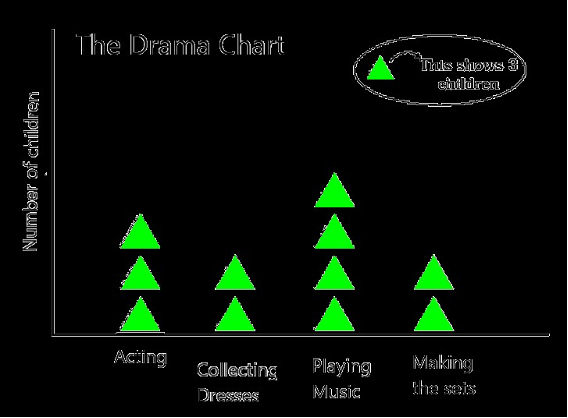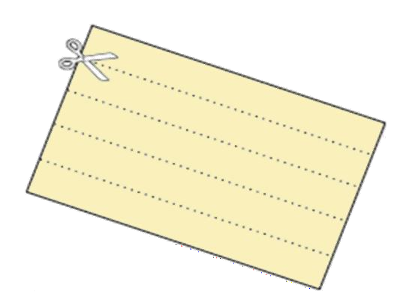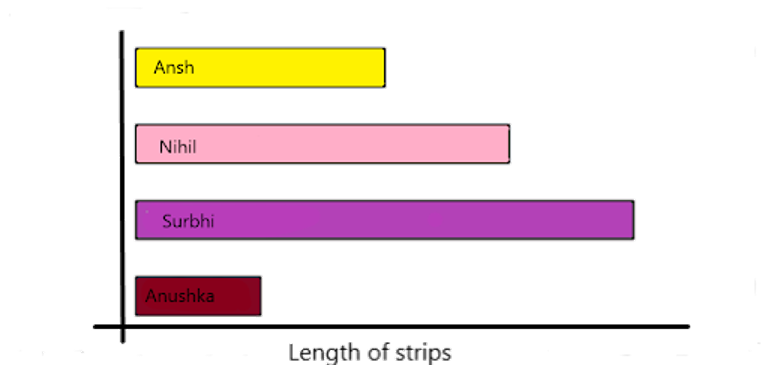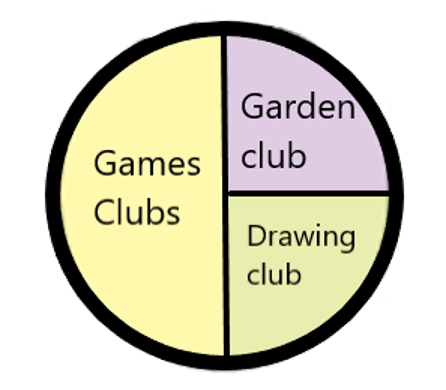NCERT Solutions for Class 4 Maths Chapter-14
NCERT textbook consists of Chapter 14 Smart Charts which consists of lots of questions in exercise as well as inside the textbook, our experts solved all the questions asked in Tables And Shares as per the CBSE guideline.
What are you going to learn in Chapter 14 Smart Charts
Download step by step explanation of NCERT Solutions for Chapter 14 Smart Charts
1. How many hours?
All of us enjoy watching television or listening to the radio.
i. How much time do we spend on this?
Ans: We spend one hour every day watching television.
ii. Note the time you spend in front of a TV or radio every day. Do this for one week. The time spent in a week is ____________ hours.
Ans: The time spent on TV in a week is seven hours.
iii. So in a month you spend about 30 × ________ = __________ hours.
Ans: For the given relation they have assumed that we watch TV for 30 days in a month. So in a month you spend about
30´1 = 30 hours
2. Find out from your friends the time they spend in a week.
| How many hours they watch TV or listen to the radio (in a week) |
Number of children |
|
More than 6 hours |
|
|
Six hours |
|
|
Five hours |
|
|
Four hours |
|
|
Three hours |
|
| Two hours | |
| One hour | |
| Zero hour (do not watch) |
Ans: I talked to my friends to know about the time they spend in a week watching television or listening to the radio. The table below shows the data I recorded.
|
How many hours they watch TV or listen to the radio (in a week) |
Number of children |
|
More than 6 hours |
30 |
|
Six hours |
25 |
|
Five hours |
25 |
|
Four hours |
25 |
|
Three hours |
20 |
|
Two hours |
20 |
|
One hour |
23 |
|
Zero hour (do not watch) |
20 |
3. From the table (Watching TV/ listening to the radio) above answer the following.
i.__________children spend more than 6 hours in a week.
Ans: From the table above, 30 children spend more than 6 hours watching TV or listening to the radio in a week.
ii.________children spend no time at all.
Ans: Twenty children spend no time.
iii. Most children spend _________ hours in a week.
Ans: Most children spend 15 hours in a week.
iv. ___________children spend more than 3 hours.
Ans: 105 children spend more than 3 hours.
4. Which Programme?
There are different types of programmes on TV or radio such as cartoons, news, sports, music, plays, and serials. Juhi’s father likes watching serials. Her mother likes sports. Juhi likes news programmes.
i. Ask people in your family to name one programme they like and one programme they dislike. Make a table.
|
Family member |
Programme they like |
Programme they dislike |
|
Mother |
||
|
Father |
||
|
Sister |
||
|
Brother |
||
|
Uncle |
||
|
Aunt |
||
|
Me |
The kind of programme most family members like_______
The kinds of programme most family members dislike _______
Ans: My family members like and dislike these programmes that are shown in the table below.
|
Family member |
Programme they like |
Programme they dislike |
|
Mother |
Movies |
Music |
|
Father |
Serials |
Cartoons |
|
Sister |
Cartoons |
Serials |
|
Brother |
Movies |
Serials |
|
Uncle |
Movies |
Serials |
|
Aunt |
Serials |
News |
|
Me |
Cartoons |
Movies |
The kind of programme most family members like is movies and cartoons.
The kind of programme most family members dislike is serials and news.
5. Find out from 20 friends the programmes they like and dislike, and write in a table.
|
Kind of programme |
Number of children liking it |
Number of children disliking it |
|
News |
||
|
Serials |
||
|
Cartoons |
||
|
Comedy shows |
||
|
Sports |
Ans: I found from 20 friends the programmes which they like and dislike.
|
Kind of programme |
Number of children liking it |
Number of children disliking it |
|
News |
5 |
15 |
|
Serials |
3 |
17 |
|
Cartoons |
20 |
0 |
|
Comedy shows |
17 |
3 |
|
Sports |
9 |
11 |
6. Answer the following questions using the table in the above question.
i. Which kind of programme is liked by most children?
Ans: Cartoons are liked by 20 children and Comedy shows are liked by 17 children so cartoons and comedy shows are the programmes which are liked by most children.
ii. Which kind of programme is disliked by the least number of children?
Ans: Cartoons and Comedy shows are the programmes which are disliked by the least number of children.
iii. How many children like sports programmes?
Ans: Nine children like sports programmes.
iv. Is there any kind of programme not liked by anyone? Yes/ No. If yes, which one?______
Ans: No. All the programmes are liked by at least one child.
7. Read the poem given below carefully and answer these questions: Who is my friend?
I’ve a friend with me always,
In the nights and through the days. When I run he runs with me,
Sometimes I lead, sometimes he does. When it’s dark he can’t be seen,
Do you know which friend I mean?
i. Which word comes most often in the poem?
Ans: The letter I come most often in the poem.
ii. Which letter has been used most?
Ans: The letter E has been used the most in the given poem.
iii. Which letter comes least?
Ans: The letters, ‘B’ and ‘V’ come least in the poem.
8. Take a paragraph you like from your language textbook. Read carefully and find out:
There are 4 houses on his land and in the middle of the land there is a well. He wants to divide this land equally among his four children.
Each should get one house and be able to use the well without entering the other’s land.
i. Which word comes most often and how many times? ______
Ans: The word ‘land’ is used most often and it is used four times in the paragraph.
ii. Which word comes least often?_______
Ans: The words, ‘are’, ‘on’ etc. come least often in the paragraph.
iii. The letter used most often is ________
Ans: The letter ‘E’ is used most often in the paragraph. It is used 26 times.
iv. The letter used least often is _______
Ans: The letters used least often are ‘F’, ‘Q’, ‘V’ and ‘Y’. These letters are used only one time.
9. Food We Eat: Children were talking about what things they eat in the morning — made of rice, wheat, maize, barley, etc. Find out from your classmates and fill the table:
|
Main food |
Number of persons |
|
Rice |
|
|
Wheat |
|
Ans: The table is completed as follows after asking the friends.
|
Main food |
Number of persons |
|
Rice |
20 |
|
Wheat |
10 |
|
Maize |
30 |
|
Ragi |
8 |
|
Barley |
7 |
10. Look at the above table and tell:
i. Most children eat food made from______ .
Ans: 30 students eat food made from maize. So, most children eat food made from maize.
ii. Compared to children who eat rice, those who eat wheat are more/ less/ equal.
Ans: Compared to children who eat rice, those who eat wheat are less.
iii. Compared to those who eat wheat, children eating ragi are more/ less.
Ans: 10 children eat wheat and eight children eat ragi. Thus, compared to those who eat wheat, children eating ragi are less.
11. Preparing for the Class Drama: All children of a class are getting ready for a drama. Some children are acting. Some are busy collecting dresses. Some are bringing tables and chairs to make the sets.

i. How many children are acting in the drama?
Ans: From the graph above, we can see that there are three triangles which represent the children doing acting and each triangle represents three children. So, a total of 9 children are acting in the drama.
ii. Which are more – children making the sets or those acting?
Ans: From the graph above, we can see that there are three triangles which represent the children doing acting and each triangle represents three children. Similarly, there are two triangles which represent the children
making sets. Thus, 9 children are doing acting and 6 children are making the sets. Therefore, the number of children doing acting is more.
iii. What is being done by most of the children?
Ans: The children doing music are represented by 4 triangles. We can see that the children doing music have the maximum triangles. Thus, most of the children are playing music.
iv. How many children are collecting dresses?
Ans: 6 children are collecting dresses.
12. Whose Head is Bigger? Cut long paper strips from waste paper. Give one strip to each of your friends. Now put the paper strip around your head and tear off the extra strip. On a big sheet, paste these paper strips along a line.

Some children had pasted their strips and made a chart like this.

Your chart should also look like this. Use a scale and find out from your chart:
Ans: The strips of my friend’s head are pasted in the chart given below.

i. The length of the longest strip is _________ cm.
Ans: The length of the longest strip is 50 cm.
ii. So _________ has the biggest head.
Ans: Surbhi has the biggest head.
iii. The smallest strip is _______ cm long. It belongs to _______ .
Ans: The smallest strip is 25 cm long. It belongs to Anushka.
13. All children of a school take part in different clubs: The Chapati Chart shows the number of children in different clubs.

Half the children in the class take part in the Games Club. One fourth of the children are members of the Garden Club. The Drawing Club has one fourth of the children of the class. If there are 200 students in the school, look at the above Chapati Chart and tell the number of members in each club:
1. The Games Club has ________ members.
Ans: The Games Club has half of the total members. We know that half of 200 is 100. So, The Games Club has 100 members.
2. The Garden Club has _______ members.
Ans: The Garden Club has one fourth of the total members. Thus,
1 / 4 x 200 = 50 . Therefore, The Garden Club has 50 members.
3. There are __________ members in the Drawing Club.
Ans: The Drawing Club has one-fourth of the total members. Thus,
1 / 4 x 200 = 50 . There are 50 members of the Drawing Club.
14. Getting wet in the Rain: Who likes to get wet in the rain? A child made this Chapati Chart after asking his friends.

See the Chapati Chart and tell:
i. How many children like to get wet in the rain?
(a) half (b) one-fourth (c) three-fourth
Ans: From the chart, we can observe that three-fourth of the children like to get wet in the rain.
ii. How many children do not like to get wet in the rain?
(a) half (b) one-fourth (c) three-fourth
Ans: From the chart, we can observe, one-fourth of the children do not like to get wet in the rain.
15. If the number of children in the class is 28, then tell the number of children according to the given conditions.
i. Who likes to get wet in the rain?
Ans: Three-fourths of the children like to get wet in the rain. So, 3 x 28 = 21.
Thus, 21 children like to get wet in the rain.
ii. Who does not like to get wet in the rain?
Ans: One-fourth of the children do not like to get wet in the rain. So, 1/4 x 28 = 7 .
Thus, 7 children do not like to get wet in the rain.
16. Tea, Coffee or Milk: Some children were asked which of these they liked most – Tea, Coffee or Milk.
|
The drink they like |
Number of children |
|
Milk |
20 |
|
Coffee |
10 |
|
Tea |
10 |
What is the total number of children?
Ans: To find the total number of children, we will add all the numbers of the right hand side column. Thus, 20 +10 +10 = 40 . Therefore, the total number of children is 40.
17. Find out from the table:
i. Children who like milk are 1/2 1/2 1/2 1/2 or 1/4 1/4 of the total children.
Ans: 20 children like milk. Total number of children is 40. So, the children who like milk are 20/40, that is, 1/2. Therefore, children who like milk are 1/2 of the total children.
ii. Children who like coffee are 1/2 or 1/4 of the total children.
Ans: Children who like coffee are 1/4 of the total children.
iii. Show the liking for Tea, Coffee or Milk in a Chapati Chart.
Ans: The Chapati Chart of children liking Tea, Coffee or Milk are given below.
